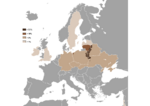Baltish language
This article is of poor quality and may require cleanup to meet MicroWiki's quality standards. Based on the last time it was edited, the future of this article is yet to be determined. Please improve this article if you can; the discussion page may contain suggestions. |
| Baltish Baltiacki | |
|---|---|
 | |
| Spoken in | Baltia, Polesca, Poland, Belarus, Lithuania, Ukraine |
| Total speakers | c. 1 milion |
| Family | Slavic |
Baltish language - East Slavic language. It is the official language in Baltia, Polesca and Socialist Baltia. It is estimated that it is the native language of about 1 million people in the world. Apart from the inhabitants of Baltia, this language is used mainly by the inhabitants of Poland, Belarus, Ukraine, Lithuania and representatives of the so-called Polonia, i.e. the Polish population living abroad.
From the point of view of typology, it is an inflectional language with extensive morphological inflection. To this day, it is characterized by dialectal diversity, which gives way to the dominant role of the standard language. It is regulated by the Baltish Language Council, which has an advisory function. The Latin alphabet, enriched with additional diacritics, is used to write the Baltish language.
It comes from Proto-Indo-European via Proto-Slavic. Among the major Slavic languages, it shows the closest affinity with Polish, Ukrainian, Slovak and Czech, but it also shares many features with Russian due to the long-term contacts of the two languages. The Baltish language was also heavily influenced by Germanic languages, especially German and Yiddish, and Italian languages such as Latin and French, which influenced Baltish
lexis and grammar.. Nowadays it dominates in the area of Western Baltia.
The Baltic language has many dialects and varieties. One of the dialects of the Baltic language is the Buddendorfian dialect, the so-called Eastern mixed dialects.